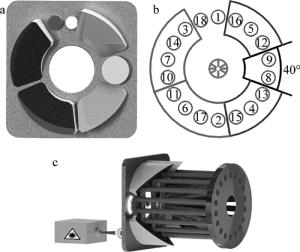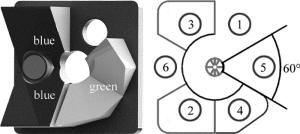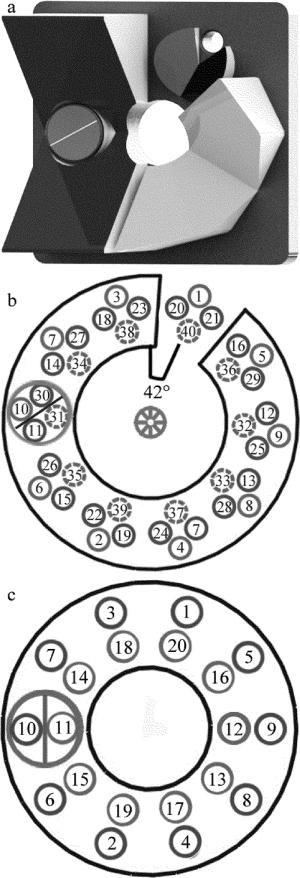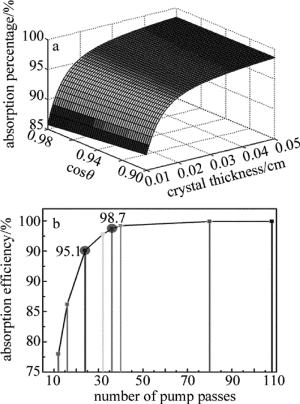-
薄片激光器[1]是一种具有高功率、高脉冲储能、高转换效率和高光束质量的全固态二极管抽运激光器。它与传统的固体激光器一样也是由抽运源、激光增益介质和耦合光腔组成,不同的是薄片激光器晶体的后向焊接耦合在热沉的前侧[2],并且输出激光沿着晶体的径向,因此薄片晶体的背面则同时充当着抽运、激光输出波长的高反射面和晶体冷却的前表面。由于薄片激光器的晶体的厚度非常薄,其典型的厚度为0.1mm~0.5mm[3],因此激光晶体的热梯度分布可以近似地看成为1维的情形[4],所以晶体热效应所引起的光学畸变就会变小,从而提高了输出光的转换效率和光束质量。虽然薄的薄片晶体可以减小晶体的热效应,但是薄的晶体却限制了对抽运光的吸收,因此会严重降低输出光相对抽运光的转换效率[5-7],而且对于高能薄片激光器来说,为了实现高功率的激光输出,同时减小晶体表面的热梯度,则需要大的抽运光斑和更薄的激光晶体,而大的光斑则需要大体积的抽运结构来与之相匹配。但是,大体积的抽运结构则无疑增加了实验的成本和加工工艺的精度,而更薄的激光晶体则更加限制了抽运光的吸收。
目前,国外以德国斯图加特大学和Trump公司为主,德国Trump公司6冲程、24冲程、48冲程的多冲程转折抽运吸收结构以成对的互补棱镜来折返抽运光并让其多次经过聚集透镜聚焦到晶体上,从而实现不同冲程的吸收[8]。国内以华中科技大学设计的离轴抛物面抽运结构[9-10]、中国工程物理研究院WANG团队设计的16冲程结构[11]和哈尔滨工业大学介绍的24冲程结构[12]为主。华中科技大学采用的是双面对称抽运非球面聚焦结构,其方法利用两个非球面共轴使抽运光经过两个透镜反射将抽运光聚焦在其中一个中间打孔的非球面中心,从而实现不同冲程的抽运吸收。中国工程物理研究院WANG团队设计的16冲程结构和哈尔滨工业大学介绍的24冲程结构则都是对德国斯图加特大学和Trump公司[13]提出的远心成像抽运结构和多对互补棱镜转折抽运光方法的改进。
因为当输出激光的转换效率相同时,多的抽运冲程数可以有效地减小薄片增益介质的厚度和掺杂浓度[14],从而可以减小晶体表面的热抗、平均温度和掺杂粒子的增益光子的散射[15],提高晶体后表面的冷却效率和输出光的光束质量。
本文中基于以上3种不同类型的抽运吸收结构,采用多次抽运吸收的方式,结合光斑离轴非对称反射抛物面和光斑对称分布非球面的抽运结构,提出了一种可以提高非球面光束分布占空比的高冲程抽运的新方法。设计了多种提高抽运吸收效率的多冲程、小体积的抽运结构,并用ZEMAX模拟验证了24冲程抽运时的光路分布和光斑位置图,通过比尔吸收定律理论计算了不同抽运冲程下薄片晶体对抽运光的吸收效率。
-
对于薄片激光器Yb:YAG准三能级的晶体,其下能级的阈值功率密度则相对较高,因此就需要抽运结构的抽运光斑在薄片晶体上有较高的重叠率和边界锐度来增加抽运功率密度,从而减小光斑的弥散像差。其中最简单的抽运结构是远心成像抽运系统:它由一对90°平面转折镜和一个聚焦球面镜或者非球面镜组成。远心成像抽运系统工作原理如图 1所示。二极管激光器耦合输出光首先通过光束整形,然后经过聚焦透镜将抽运光第1次准直会聚到薄片晶体上,而第1次没有被吸收的抽运光则会通过晶体后表面反射膜的反射进行第2次吸收,经过反射的抽运光则会再一次经过聚焦透镜聚焦,然后经过一对90°转折棱镜改变抽运光在聚焦透镜上的位置进行第2次准直会聚,从而实现在晶体上的第3次吸收;第2次经过晶体后表面的反射后,晶体则会第4次吸收第3次未被吸收的抽运光,然后按照图中④的位置经过透镜和转折棱镜到达平面端镜,从而实现8冲程的抽运吸收。对于更高的抽运冲程,此方法需要增大聚焦透镜和转折棱镜的尺寸,而且光斑在聚焦透镜上的空间占空比也不高。当提高二极管的抽运功率时,此方法由于是投射式聚焦所引起的光学像差也会改变光斑在晶体上的重叠率,严重时会影响输出光的光束质量。所以,在高功率、高冲程、小体积的结构设计中此方法就显得不太实用。
-
为了提高抽运冲程的次数,同时减小抽运结构的体积,相对于远心成像的抽运结构和华中科技大学设计的双面对称抽运结构,作者提出了一种离轴抽运吸收结构,并且通过转动结构的相对角度就可以实现不同冲程的吸收,设计的离轴反射式抛物面系统如图 2a所示。该结构中所包含的是一个薄片晶体、一个大的非球面抛物镜和两个镀高反射率(high reflectance, HR)膜的柱面棱镜。由于是离轴聚焦的光学抽运结构,其光束聚焦是不对称分布的,相对于图 1的抽运结构,图 2a中的长方形棱镜替代了上例中的两个柱面棱镜,而且其中一个柱面棱镜相对于另一个柱面棱镜有一个角度θ的旋转,角度θ的旋转则决定了抽运冲程数的大小。
结合图 2b中柱面棱镜上光斑的位置分布图,能够更清楚地理解在多冲程离轴抛物面抽运光路中的光束轨迹和路径。图 2b中,数字①代表了所校准的耦合光束,其经过非球抛物面反射后会传播到薄片晶体上,而剩下的抽运光将会从薄片后表面反射进行第2次吸收,然后再一次被非球面的抛物镜准直到柱面棱镜上②的位置,同样抽运光束又会被转折棱镜转折到棱镜上③的位置。因此,通过③的抽运光则会按照非球面抛物面镜、薄片晶体、非球面抛物镜和柱面棱镜的顺序以此到达④的位置。以此类推,薄片晶体上就会产生多次的迭代吸收。本例中的结构为16冲程、32冲程的吸收。
如上所述,两个柱面棱镜之间的夹角决定了抽运冲程的次数。因此,可以通过减小二者之间的相对间隔,来增加抽运冲程的次数,如果用N来代表抽运冲程的总数,则N=360/θ。但是,如果抛物面镜的大小和焦距一定时,通过减少光斑间隔的角度来增加抽运冲程的次数就会减小了远视场光斑的抽运尺寸和抛物面镜、柱面棱镜的表面占空比(抽运冲程述越高,抛物面镜和柱面转折棱镜的体积就越大),而且在远视场上柱面棱镜的光斑也可能会变得重叠起来,所以这种方法要求结构具有非常高的调节精度。
-
对于现有的商用薄片激光器,其典型的抽运光学系统是由德国科学家GEUSIC和GIESEN所提出来的,目前商用的薄片激光器的输出功率已经达到16kW,并且应用在激光加工、焊接、熔覆等各个领域。虽然德国所设计的泵模块已经商业化,但是从可查阅的文献中能够了解到其冲程数多为16冲程、24冲程、48冲程,且没有明确的说明。基于现有薄片激光器的产品模块和参考文献的相关报道,本文中设计了12冲程、24冲程、36冲程的结构,并且也提出了一种小体积、高空间利用率的抽运结构新方法。
-
图 3a为12冲程的抽运结构。相对于德国抽运6冲程的吸收结构,该系统结构则增加了一对转折棱镜,该结构包括一个薄片激光晶体、一个非球面反射镜、一个平面端镜和两对90°折返柱面棱镜。从半导体抽运源发出的光经过非球面抛物镜和一对90°蓝色棱镜会将光束3次聚焦在晶体上,见图 3b中光斑位置分布的①、②、③,经过非球面准直的抽运光会再经过另一对90°转折绿色棱镜将抽运光3次最后聚焦在晶体上,从而实现了晶体对抽运光的6次会聚、12次的吸收。
-
国内大多选择16冲程的抽运结构,但是在高能激光武器或者输出更高功率时,16冲程的抽运吸收效率显然是不够的,而24冲程的抽运结构对于千瓦级功率的激光器设备却是非常实用的,因为增加的冲程吸收可以大幅度地提高抽运结构的吸收效率和输出光的转换效率[16]。图 4a为24冲程的抽运结构,从图中可以看到,整个抽运系统由一个非球面的抛物镜、4个反射的棱镜和一个平面端镜组成。抽运光首先会通过非球面聚焦在晶体上,聚焦在晶体上的光会反射到一对蓝色的柱面棱镜上,如图 4b中光斑的分布图,从柱面棱镜反射的抽运光则会再一次聚焦到晶体上,第4次迭代以后,抽运光会反射到另一对绿色的柱面棱镜上,经过多次的迭代,验证设计的准确性,本文中将所设计的抽运结构通过光路分析软件ZEMAX进行了光路和光斑分布的模拟,经过仿真, 如图 4c所示, 12个光斑在柱面棱镜和端镜上的分布完全满足实验初期所设计的抽运结构,进一步验证了24冲程抽运的合理性。
-
24冲程的抽运系统具有紧凑的体积、抽运吸收效率高的优点,但是当抽运光的功率不断升高时,由于24冲程抽运光路的顺序为顺时针的方向,如图 4b所示,光斑的分布从1~12都为顺时针的方向,因此晶体上的光斑会因系统的结构误差而变得弥散模糊,使得晶体上光斑的重叠率变得很小,光波像差畸变会变大,故基于此并结合离轴反射式非球面抽运光反向补偿光程的特点,本文中用一个角锥棱镜实现了36次抽运吸收的光程补偿的抽运结构。如图 5a所示,该系统结构包括一个薄片激光晶体、一个非球面反射镜、一个角锥棱镜、一个平面端镜和两个90°折返柱面棱镜组成。如图 5b所示,从半导体抽运源发出的光通过非球面抛物镜和90°棱镜将光束聚焦在晶体上,同24冲程一样光斑会不断的迭代,但是当到达光斑⑧的位置时,通过角锥棱镜的光会折返在⑨的位置上,而此后的光路会相对前8次的顺序以相反的方向多次会聚在非球面透镜上,从而实现了9个~18个光斑逆时针方向的迭代吸收。正反顺序的相互补偿,则会提高晶体上光斑分布的重叠率,从而减小了光斑分布的像差畸变,增加了输出光的转换效率。

Figure 5. a—36 passes pumping schemes b—corresponding draw of distributed pumping light c—36 passes pumping contour of laser's output light schemes
抽运光经过多次的聚焦,晶体增益介质的粒子数就会反转,而由增益介质和一个耦合输出腔镜所构成得谐振腔,就可以得到稳定的激光输出。图 5c为该冲程的整体结构图。该薄片激光器的结构简单、抽运光斑均匀、增益介质冷却效率高,所以可以应用在高能激光系统中从而实现高的转换效率和光束质量。
-
通过对离轴非球面转折聚焦系统、德国Trump公司的抽运模块和作者所在课题组所改进补偿光斑的抽运结构的认识和总结,发现如果将离轴式的非球面转折聚焦系统转折光路的思想和对称式非球面对称式的光斑抽运结构相结合,则可以获得更高抽运冲程数的抽运结构,而且得到的抽运结构其体积更小、吸收效率更高,在同等非球面的尺寸大小时,还可以获得对非球面空间更高的占空比。如图 6a所示, 通过利用一个角锥棱镜和一对90°转折棱镜可以在非球面棱镜上实现多次迭代的抽运吸收。如图 6b所示,抽运光从1的位置进入到非球面,然后经过薄片晶体的第1次吸收,抽运光会从晶体后表面反射回来入射到非球面上进行准直,与上面的抽运结构一样抽运光会一直到达光斑B10的位置,而此时再通过角锥棱镜的全反射性将抽运光对称反射到B11的位置,但是光斑则相对于入射光B10的位置会发生倾斜双侧对称的分布,而倾斜的角度则决定了光斑在角锥棱镜上的位置分布。然而从图 6c上B10和⑨的相对位置来看,其本应该在非球面的x轴上对称分布,所以为了实现在角锥棱镜左上角的位置分布,则需要在36°的基础上额外增加6°的倾斜(不一定非是6°取决于晶面尺寸的大小),从图 6b可以看到, 光斑的实际入射角度为42°。同样按照上面24冲程光斑分布的顺序结构图,光束多次迭代后到达B20的位置,由图 6a可以看到, 再利用一个90°反射圆角折叠镜将光路的光斑反射在B21的位置,再按照如图 6b光斑分布的迭代顺序,光斑会一直到达B30的位置,此刻光束可以通过一个小的附加的吸收端镜而结束光束的抽运传播,当然从图上的虚线的圆圈也可以知道,再一次利用角锥棱镜的全角度反射而再一次增加抽运光斑的冲程数,从而实现翻倍式的抽运吸收,只是最后光斑其会结束分布在B40的位置。通过图 6a中的结构,其实可以延伸出很多不同结构的抽运的结构,图 6c所示为小体积、简单分布和高效率的40冲程分布结构光斑图,其中转折的棱镜不只可以选择角锥棱镜,也可以是具有光学补偿的90°折返棱镜。通过类似的思想就可以来设计实现更高吸收冲程数的抽运结构。
-
随着抽运冲程数N的增加,抽运结构的失调灵敏度和所需要的加工的精度也是必须要考虑的。例如,所成型的柱面棱镜对可能不是绝对的正交,或者柱面棱镜的界面不能够正交于对称轴,而这些失调都将会引起在薄片中心光斑重叠的偏差。因此,选择具有逆向光束的抽运传播的结构则可以得到很大的补偿, 例如本文中所设计的36冲程的结构。但是,抽运吸收效率则是更需要考虑的,因为随着抽运冲程数的不断增加,光学抽运吸收效率的增量其实也在不断地放缓,所以有必要来对抽运效率效率进行模拟和计算,从而来选择最佳的抽运冲程数。
以薄片激光器Yb:YAG晶体为例,晶体的吸收系效率是由晶体的特性(厚度、大小、掺杂浓度、吸收系数)所决定的。而本文中所计算用的Yb:YAG晶体结构Yb掺杂原子数分数为0.1、厚度0.3mm;通过分光光度计所测量计算的吸收系数为9.75cm-1[17]。利用比尔吸收公式和不同吸收冲程结构的推导公式可以计算不同吸收冲程的吸收效率为:
$ P = PR\left[ {1 - \exp \left( { - \frac{{\alpha L}}{{\cos \theta }}} \right)} \right] $
(1) $ \left\{ \begin{array}{l} {P_1} = P{R_1}\left[ {1 - \exp \left( { - \frac{{\alpha L}}{{\cos \theta }}} \right)} \right]\\ {P_1}^\prime = P{R_1}\exp \left( { - \frac{{\alpha L}}{{\cos \theta }}} \right) \end{array} \right. $
(2) $ \left\{ \begin{array}{l} {P_2} = P{R_1}{R_3}\exp \left( { - \frac{{\alpha L}}{{\cos \theta }}} \right) \times \\ \;\;\;\;\;\;\left[ {1 - \exp \left( { - \frac{{\alpha L}}{{\cos \theta }}} \right)} \right]\\ {P_2}^\prime = P{R_1}{R_3}\exp \left( { - \frac{{2\alpha L}}{{\cos \theta }}} \right) \end{array} \right. $
(3) $ \begin{array}{l} \;\;\;\;{P_3} = {P_2}^\prime {R_1}{R_2}{R_1}\left[ {1 - \exp \left( { - \frac{{\alpha L}}{{\cos \theta }}} \right)} \right] = \\ P{R_1}{R_3}{R_1}{R_2}{R_1}\left[ {1 - \exp \left( { - \frac{{\alpha L}}{{\cos \theta }}} \right)} \right]\exp \left( { - \frac{{2\alpha L}}{{\cos \theta }}} \right){\rm{ = }}\\ \;\;\;\;P{R_1}^3{R_3}{R_2}\left[ {1 - \exp \left( { - \frac{{\alpha L}}{{\cos \theta }}} \right)} \right]\exp \left( { - \frac{{2\alpha L}}{{\cos \theta }}} \right) \end{array} $
(4) $ \begin{array}{l} \eta = \frac{{{P_1} + {P_2} + {P_3} + \cdots }}{P} = R\left[ {1 - \exp \left( { - \frac{{\alpha L}}{{\cos \theta }}} \right)} \right] + \\ \;\;\;\;\;\;{R^2}\exp \left( { - \frac{{\alpha L}}{{\cos \theta }}} \right)\left[ {1 - \exp \left( { - \frac{{\alpha L}}{{\cos \theta }}} \right)} \right] + \\ \;\;\;\;\;\;{R^5}\exp \left( { - \frac{{2\alpha L}}{{\cos \theta }}} \right)\left[ {1 - \exp \left( { - \frac{{\alpha L}}{{\cos \theta }}} \right)} \right] + \cdots \end{array} $
(5) 式中,R为器件反射率,R1, R2, R3分别为非球面、柱面棱镜和晶体后表面的反射率;P为抽运功率;P1, P2, …为不同冲程下的吸收功率;P1′,P2′为第1、2次吸收后剩余的抽运功率;α为吸收系数;θ为不同的入射角;L为薄片掺杂厚度。
为了方便模拟计算,则认定非球面、柱面棱镜和晶体后表面的反射率都为99.5%。图 7a为24冲程抽运吸收结构3-D图,从图中可以看到:不同的角度和不同的厚度都会引起吸收效率的改变,因此本文中所计算的不同结构的吸收效率都是以20°入射、厚度为300μm来进行的。如图 7b显示24冲程的吸收效率为95.1%(不考虑晶面的散射损耗和晶体的量子亏损);36冲程的吸收效率为98.7%,从36冲程以后吸收效率的斜率增加量趋于平缓。这也解释了为什么在本文中没有进一步设计趋于100冲程以上的抽运结构。通过比较,在中高端高能薄片激光器抽运结构设计中,36冲程的抽运设计则具有更高的性价比。
-
介绍了远心成像抽运结构、离轴抛物面抽运结构和德国商用抽运模块的优点和异同,通过比较设计了12冲程、24冲程和36冲程补偿式薄片激光器的抽运结构,利用现有的结构特点,将离轴抽运和对称分布抽运结合起来,提出并设计了更高冲程的抽运结构,并通过转折不同的角度获得了较高的非球面空间占空比。最后通过比尔吸收公式近似计算了不同抽运冲程下的吸收效率,计算结果表明, 36冲程的抽运结构具有高的性价比。
高冲程薄片激光器抽运结构的设计
Design of multipass pump schemes for thin disk lasers
-
摘要: 为了实现薄片激光器高吸收转换效率的目的,采用多次抽运吸收的方式,结合光斑离轴非对称反射抛物面和光斑对称分布非球面的抽运结构,提出了一种可以提高非球面光束分布占空比的高冲程抽运的新方法。设计了多种不同抽运冲程的结构,使用ZEMAX模拟验证了24冲程抽运时的光路分布和光斑位置图,通过比尔吸收定律理论计算了不同抽运冲程下薄片晶体对抽运光的吸收效率。结果表明,所设计的24冲程、36冲程、40冲程和80冲程的抽运结构,其中36冲程的吸收效率的性价比最高。该研究对高功率、高冲程、小体积的抽运结构设计具有指导作用。Abstract: In order to achieve high absorption and conversion efficiency of thin disk lasers, the method of multiple pumping absorptions was adopted. Combining with the pumping structure of light spot asymmetric parabolic surface and light spot symmetrical aspheric surface, a new method of high pumping passing was proposed to improve the duty ratio of aspheric beam distribution. The multipass pumping structure was designed. The optical path distribution and spot position diagram of 24 passes pumping schemes were simulated by using ZEMAX. Absorption efficiency of thin disk crystal on pump light with different pumping passes was calculated theoretically according to Bill's absorption law. The results show that among the designed pump structures of 24 passes, 36 passes, 40 passes and 80 passes schemes, the absorption efficiency of 36 passes pumping scheme is the most cost-effective. The research has guiding function for the design of small multi-pass pumping structures with high power.
-
Key words:
- optical design /
- thin-disk laser /
- pump scheme /
- absorption efficiency /
- pump pass
-
-
[1] SUMIDA D S, FAN T Y. Effect of radiation trapping on fluorescence lifetime and emission cross section measurements in solid-state laser media[J]. Optics Letters, 1994, 19(1):1343-1345. [2] BRAUCH U, GIESEN A, BRAUCH U, et al. Multi-watt diode-pumped Yb:YAG thin disk laser continuously tunable between 1018 and 1053nm[J]. Optics Letters, 1995, 20(7):713-715. doi: 10.1364/OL.20.000713 [3] KIM H S, YANG J M. Dependence of the temperature of a Yb:YAG disk laser crystalon the pump laser's spot size and the disk's thickness[J]. Applied Optics, 2009, 55(4):1425-1429. [4] JOHNSON L F, GEUSIC J E, van UITERT L G, et al. Coherent oscillators from Tm3+Ho3+Yb3+ and Er3+ ions in YAG[J]. Applied Physics Letters, 1965, 7(5):127-130. doi: 10.1063/1.1754339 [5] REINBERG A R, RISENBERG L A, BROWN R M, et al. GaAs:Si LED pumped Yb doped YAG laser[J]. Applied Physics Letters, 1971, 19(1):11-13. doi: 10.1063/1.1653723 [6] LIU Q, GONG M L, LU F, et al. Efficient corner pumped Yb:YAG/YAG composite[J]. Applied Optics, 2006, 45(16):3806-3810(in Chinese). doi: 10.1364/AO.45.003806 [7] GIESEN A, HUGEL H, GEUSIC J E, et al. Progress towards high-power high-brightness neodymium-based thin-disk lasers[J]. The International Society for Optical engineering, 2004, 28(1):305-344. [8] SCHUHMANN W, HÄNSCH K, KIRCH T, et al. Thin-disk laser pump schemes for large number of passes and moderate pump source quality[J]. Applied Optics, 2015, 32(54):1559-1568. [9] SONG X. Design and experiment research of resonators for high-power disk laser[D]. Wuhan: Huazhong University of Science and Technology, 2012: 30-42(in Chinese). [10] DUAN X B. Analysis of the thermal lens effect on Yb: YAG thin disk laser crystal[D].Wuhan: Huazhong University of Science and Technology, 2011: 20-34(in Chinese). [11] WANG C H. Design and experiment of multi-pass pump system for Yb:YAG thin disk laser[J].High Power and Particle Beams, 2010, 37(11):2795-2798(in Chinese). [12] ZHOU X. Continuous-wave and pulse output performances for Yb: YAG thin disk laser[D]. Harbin: Harbin Institute of Technology, 2012: 38-40(in Chinese). [13] JAVADI-DASHCASAN M, HAJIESMAEILBAIGI F, RAZZAGHIET H, et al. Optimizing the Yb:YAG thin disk laser design parameters[J]. Optics Communications, 2008, 281(18):4753-4757. doi: 10.1016/j.optcom.2008.05.055 [14] VOSS A, WEICHELT B, AHMED M A, et al. Enhanced performance of the thin-disk lasers by pumping into the zero-phonon line[J]. Optics Letters, 2012, 47(15):254-259. [15] GIESEN A, HUGEL H, GEUSIC J E, et al. Progress towards high-power high-brightness neodymium-based thin-disk lasers[J]. The International Society for Optical Engineering, 2004, 28(1):305-344. [16] MA Y, WANG Ch H, WANG W M, et al. 16-pass pumped micro-channel cooled Yb:YAG thin disk lasers[J]. Laser Technology, 2011, 35(1):82-85(in Chinese). [17] WANG X D. Research on diode pumped thin disk laser[D]. Changchun: Changchun University of Science and Technology, 2016: 7-21(in Chinese). -


 网站地图
网站地图


 下载:
下载:







